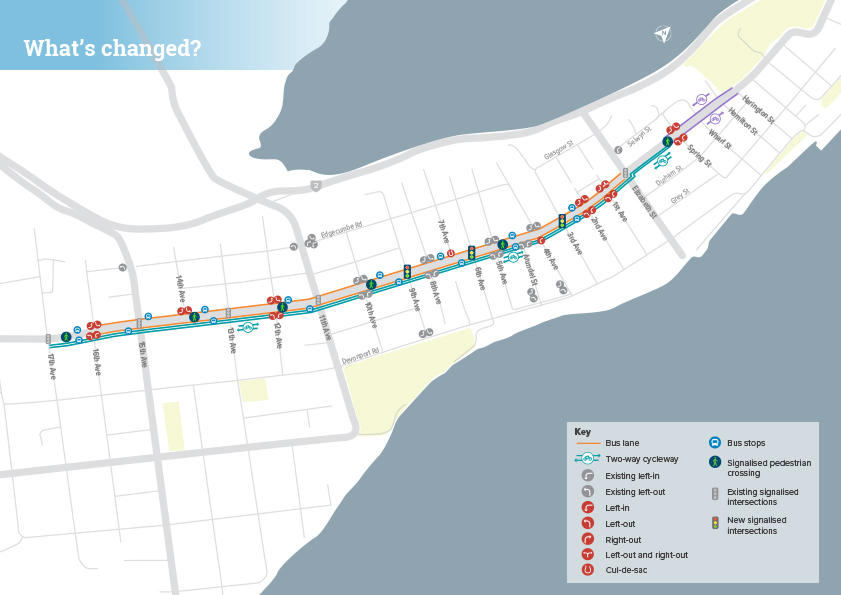Changes include a new two-way cycleway, more pedestrian crossings, and upgrades to stormwater and wastewater. We’ve also made improvements to make the area more walkable, attractive and community friendly. This includes new plantings that reflect the history of the area, attract bird life, and create spaces for the community to spend time in. Businesses have the opportunity to interact with the street and create outdoor dining areas. Two traffic lanes have been retained in both directions. Other changes include road layout changes to some of the side-road intersections connecting with Cameron Road, and new part-time bus lanes that will come into effect in mid-2024.
Input from the community
Feedback from the community in the early stages of the project informed the detailed design plans that have made Cameron Road safer, more attractive, and provided more ways for us all to travel through Te Papa peninsula.
Cameron Road - Detailed design drawings for Harington Street to 17th Avenue (24mb pdf)
As part of this project, mana whenua helped us explore and understand the whakapapa of Cameron Road. Our design team worked under the principles of Ahi Kaa to encourage people to reconnect with the cultural and historical richness of the area. Together we prepared Ahi Kaa, the cultural and urban design framework for the proposed Cameron Road project. This document begins by remembering the past, reflecting on the whakapapa of Cameron Road (Inamata), before describing its context today (Onamata), and then moving onto the project itself (Anamata). We encourage you to take time absorbing the significant cultural and historical context of this project, before progressing to the design outcomes (Te Ahi).
Ahi Kaa – Part 1 (Inamata, Onamata and Anamata) (24mb pdf)
Ahi Kaa – Part 2 (Te Ahi) (16mb pdf)
What are the improvements?
Places for people - We’ve added more crossings for pedestrians and cyclists and included seating and planting to create a place people want to spend time in.
Cycleway - A high quality separated two-way cycleway on the eastern side of the road between Spring Street and 17th Avenue.
Road layout changes - Some road intersections connecting with Cameron Road have improved to create a safer and more pedestrian and cycle-friendly area.
Environment - Stormwater treatment along the road has been improved.
Utilities - This major upgrade has also futureproofed growth by replacing and upgrading aged and undersized wastewater and drinking water services. Some sewer pipes underneath Cameron Road were made of clay and more than 100 years old – these have been replaced. This work was funded through the City Waters Capital Budget.
Left-in-left-out - Some intersections are now left-in-left-out.
Bus lanes and stops - We’ve improved bus stops to make journeys better for bus users and added bus lanes to improve bus network reliability. Activation of the bus lanes will be considered by Council in early 2025.

What's changed map (79kb pdf)
Trees and plants
Trees and plants are a main feature of the new Cameron Road design. They have many benefits – from creating spaces that people want to spend time in, providing shade, softening footpaths and roads, to connecting people with nature and attracting native bird life. They also reflect the history of the area.
The existing trees along Cameron Road are important to us and our community and of the 260 trees within the construction area we removed 18 trees for construction and safety reasons (nine in the verge and nine in the median) including tulip trees, jacaranda and one swamp oak. Exact locations of trees impacted can be found within the detailed design plans.
There are a number of existing trees within the construction area which are protected under the Tauranga City Plan. None of these are impacted by the project.
Our protected trees include:
- Group of trees outside of Tauranga Boys’ College
- Group of trees within Tauranga Primary School between Fifth Avenue and Arundel Street
- 1 Blue Atlas tree on the corner of Spring Street and Cameron Road
- Norfolk Island Pine – 198 Cameron Road, adjacent to Toi Ohomai campus
- 1 Pohutukawa tree on the east side of Cameron Road and Eleventh Avenue.
New trees and plants include both natives and exotics and were planted along the sides of Cameron Road in the median strips that separate the footpaths, vehicle lanes, bus clearways and cycleway, and within some areas of retained central median.
Overall, there will be a significant increase in trees and greenery with around 90 new canopy trees and 350 sub-canopy trees. This includes large canopy trees such as pohutukawa, puriri and totara, smaller sub-canopy trees such as cabbage trees, nikau and lancewood, and floor planting including taro, turutu and New Zealand daphne which we know will grow well in this area, attract bird life and be around for a long time to come.
Some planting will not be done until the 2024 planting season – May to August - to give the new plants a better chance to thrive.
Why we didn't build more traffic lanes
Tauranga is made up of several narrow peninsulas that funnel traffic into key pinch points that cause traffic congestion during busy times of the day. The shape of these peninsulas and the limited space available means building more roads is not a viable solution. Knocking down homes and businesses to build roads is not only costly but also reduces the attractiveness and value of these areas, severs communities, and most of all, doesn’t fix congestion.
We need to find smarter, more space-efficient modes of transport such as public transport, cycling and walking. This is what Building our future - Cameron Road, Te Papa aims to deliver.
Building our future - Cameron Road, Te Papa is not a project specifically geared to ease traffic congestion for people that travel by car. However, a bonus of enabling more ways for people to travel along this route will reduce car dependency which will help improve journeys for those who travel by car.